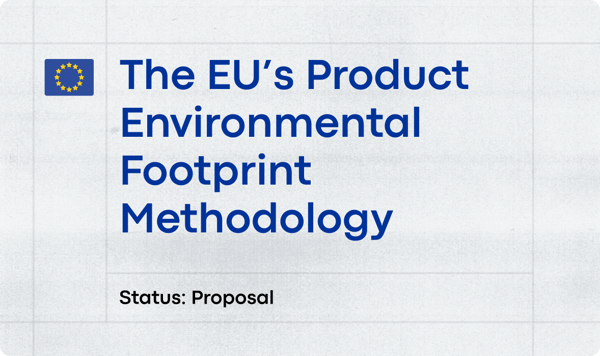In the ever-evolving landscape of consumer protection and environmental responsibility, understanding the regulatory frameworks that govern commercial practices in the textile industry is essential. In this post, we’re delving into two European Union directives that hold significant implications for the fashion and textile industry: the existing Unfair Commercial Practices Directive and the upcoming Green Claims Directive. We aim to unravel the complexities of these directives and shed light on how these regulations directly impact fashion and textile brands. Visit our textile regulations resource hub to find more deep dives.
What are the UCPD and the Green Claims Directive?
The Unfair Commercial Practices Directive (UCPD) was implemented in 2005, spanning a broad spectrum of consumer protection issues. Its aim was to protect consumers—and boost consumer confidence—by prohibiting deceptive marketing practices and ensuring fair business conduct. It wasn’t until December 2021, however, that it was revised to include guidance on how sustainable claims can be made. As of today, the UCPD is the only EU regulation that directly addresses claims about the environmental impact of a product or brand.
That will soon change. The Green Claims Directive was proposed in March 2023 with the goal of providing more specific rules about environmental claims. This directive will require companies to substantiate any green claims, detail guidance on how to communicate them, and introduce rules on environmental labeling.
The easiest way to think about the UCPD and the forthcoming Green Claims Directive is to visualize them working in tandem. The Green Claims Directive compliments the existing UCPD by setting specific rules for companies to adhere to, largely on substantiation and verification.

How does the UCPD impact environmental claims and labeling schemes?
While the UCPD applies to a broad range of commercial practices, we’re going to focus on how it applies to environmental claims and labeling.
- According to the UCPD, the term “environmental claims” refers to “the practice of suggesting or otherwise creating the impression (in a commercial communication, marketing or advertising) that a good or a service has a positive or no impact on the environment or is less damaging to the environment than competing goods or services.”
Here are a few real-life examples of recent greenwashing claims by fashion and textile brands:
- Claiming that a polyester garment is “recycled” when it’s actually non-recyclable at its end-of-life
- Advertising the “energy-efficiency” of a brand’s retail locations, when little effort is made to reduce the environmental impact of its production or supply chain
- Promoting a new clothing line as “green” or “sustainable” when only a small percentage of the materials are recycled or low-impact
While more generic than the Green Claims Directive, the UCPD provides some direction on how to make voluntary environmental claims.
- Any claim should take into consideration a product’s environmental impact across its entire lifecycle, including supply chain.
- Environmental claims about a specific product should relate to that product and not the company’s general sustainability practices. For example, if your company uses a certain percentage of recycled materials across an entire product line, this metric cannot be applied to an individual product that does not contain any recycled materials.
- Claims should be clear and unambiguous, particularly in regard to the number of key environmental impacts of a product. If a product has several impacts, but a brand only highlights one, that would be considered misleading. Think: lying by omission.
- While companies can claim that a product has a lower environmental impact than competing items—or previous versions of the same product—a comparative assessment must be carried out using the same method and criteria.
UCPD has already been implemented in cases against major fashion retailers such as H&M and Decathlon. Following an investigation by the Netherlands Authority for Consumers and Markets (ACM), both brands were found to have shared misleading environmental and sustainability claims such as “Conscious” and “Ecodesign” without providing any context or clarity into their meaning.
Tip: Talking about the environmental impact of our companies and products/services is complex. Check out this detailed playbook from the United Nations Environment Program to level up your communications strategy.
How will the Green Claims Directive impact environmental claims and labeling practices?
In response to the swelling number of companies promoting their green credentials, the Green Claims Directive aims to help consumers understand and trust the veracity of these claims. This directive takes the groundwork laid by the UCPD and builds upon it.
The Green Claims Directive pertains specifically to voluntary business-to-consumer environmental claims. The requirements laid out in the directive would take precedent over the UCPD and would apply to any voluntary environmental claims or labelling schemes not regulated by other EU acts.
The big change presented by the Green Claims Directive is the mandate that companies carry out an assessment of their claims. This includes, but is not limited to:
- Specifying if the claim concerns the whole product or part of it (i.e. not applying a company’s general efforts to combat “fast fashion” to an individual product’s environmental footprint.) (new)
- Basing claims on valid scientific evidence (already in UCPD)
- Looking at the entire lifecycle of the product (already in UCPD)
- Taking all environmental impacts into consideration before assessing the overall performance (new)
- Ensuring that any positive environmental achievements have not come at a negative cost to climate change, resource consumption, pollution, and biodiversity among other criteria (new)
The level of detail required by the Green Claims Directive demands comprehensive insight into your business practices. Implementing a carbon management tool like Carbonfact can simplify the requirements demanded by EU legislation like the Green Claims Directive. Reach out to our team of climate experts and data scientists to learn how we can help your brand.
In addition to verification, the Green Claims Directive also targets the abundance of environmental labeling schemes and provides clear guidance on their operation. There are numerous examples of fashion brands advertising an “eco-label” of their own creation. Learn more about environmental labeling schemes here.

What is the timeline for the Green Claims Directive?
Since it was proposed in early 2023, the directive has been progressing through the EU legislative process and is expected to be voted upon in June 2024. Once implemented, EU membership states will have 2 years to build their own national laws will have 24 months to comply. It’s worth noting that the Green Claims Directive will apply to all businesses making voluntary environmental claims, with the exception of microenterprises with fewer than 10 employees and less than €2 million in turnover.
How to Prepare for the Green Claims Directive?
The best way to prepare for the Green Claims Directive already now is to dive into the UCPD requirements and comply. With regulations like the Unfair Commercial Practices Directive and Green Claims Directive, brands will need to have deep insights into their products’ environmental footprint.
Carbonfact is a Carbon Management Platform tailored to the needs of fashion and textile brands. We help you run product life cycle assessments (LCA) for your whole catalog in just a few weeks time. Apparel and footwear brands can get a clear and accurate view of your products' environmental footprints and measure all the data they need to make claims that are compliant with both the UCPD and Green Claims Directive.







 Lidia Lüttin
Lidia Lüttin

![[Guide] Carbon accounting for fashion, textile, apparel, and footwear companies](https://www.carbonfact.com/hs-fs/hubfs/CA%20-%20Opt1.png?width=600&name=CA%20-%20Opt1.png)
 Angie Wu
Angie Wu